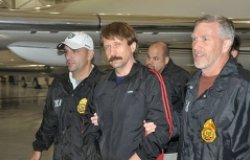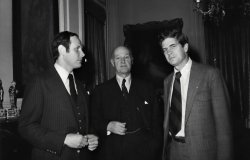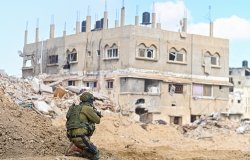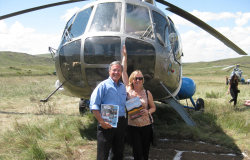Hans Kammler, Hitler’s Last Hope, in American Hands


To download this Working Paper, please click here.
Frank Döbert and Rainer Karlsch
CWIHP Working Paper #91
Hans Kammler, Hitler’s Last Hope, in American Hands
Frank Döbert and Rainer Karlsch
August 2019
Immediately after the end of World War II, the victorious powers began to interrogate the functional elites of the National Socialist state. When the question came to the German V-weapons programs, jet fighters and underground armament factories, the name of Hans Kammler was mentioned again and again. In the final phase of the war, the SS Obergruppenfuehrer and head of the Office of Unit C of the Economic Administration Main Office of the SS had been given far-reaching competences for the production and use of the latest weapons. The Allies were aware of Kammler, even though they knew far from everything about his “underground shadow realm,” his role in the Holocaust and the mass use of concentration camp inmates in construction projects. They searched intensively for him, but, according to the standard narrative until only a few years ago, came too late. Kammler had allegedly evaded his culpability and committed suicide in Bohemia on 9 May 1945. Doubts about this account, however, were never completely silenced, especially since his body was never located and all personal documents remained missing. Gerald Fleming, a leading Holocaust researcher, wanted certainty but could not find sufficient evidence to prove that the suicide narrative was not true. Fleming urged us not to let the story rest but to continue the research. [1]
In the article „Ein inszenierter Selbstmord. Überlebte Hitlers „letzter Hoffnungsträger“, SS Obergruppenführer Hans Kammler den Krieg? [A staged suicide. Did Hitler’s “Last Hopeful,” SS Obergruppenfuehrer Hans Kammler, Survive the War?], published in the Zeitschrift für Geschichtswissenschaft in 2014, for the first time declassified documents and statements were presented which suggest that Hans Kammler was captured by the Counterintelligence Corps, an American military intelligence service. The most important evidence for this thesis was a report by special investigator Oscar Packe dated August 1949.[2] Packe, who worked for the department of the U.S. military government in Hesse responsible for denazification, concluded his report as follows: “The suicide of the subject, suspected and allegedly confirmed by the witnesses, is refuted by the CIC’s precise information about his capture and escape in May 1945. Evidence that the subject is now in Soviet custody and is to work in the Soviet occupation zone of Germany could not be provided here.”[3]
Packe had been informed by the CIC of Kammler’s capture and subsequent escape. Was it possible for a high-ranking SS general and his staff to escape from American captivity? Was he really arrested with his staff at the Messerschmidt works in Oberammergau, as the Packe report states, “by American troops on 9 May”? And was able to escape from there with senior SS leaders of his staff? Did the events in fact take place near the underground Messerschmitt plant “Bergkristall” in Gusen, near Linz? It is likely that Packe did not learn the true circumstances of Kammler’s arrest from the Counter Intelligence Corps. Recently Donald W. Richardson, a special agent of the CIC and the Office of Strategic Services (OSS), has emerged as a key.[4] Shortly before his death, he told his sons that he had brought Hans Kammler to the United States. For reasons of national security, he had to remain silent about it. Despite these sources and Richardson’s statement, doubts about the chain of circumstantial evidence persisted.
Now, however, newly obtained documents prove unequivocally that Hans Kammler was indeed captured by U.S. services. The documents were discovered by two researchers independently of each other: Marek Michalski of Poland, affiliated with the museums of former concentration camps in Treblinka, Stutthof and Groß-Rosen, and the Linz-based television journalist Andreas Sulzer of Austria.
Kammler’s rise
Before we analyze the new sources, a few words about Kammler’s career. Between 1919 and 1923, Hans Kammler studied architecture at the Technical University of Gdansk and the University of Munich and in 1932 received his Ph.D.[5] He had joined the NSDAP as early as 1931 and became a member of the SS in 1933. He was active until 1937 in the party organization of the NSDAP, partly in a leadership position. Professionally, he rose rapidly from 1933 on: after serving as the leader of the Reich Federation of Small Gardeners and Settlers Germany (Reichsbund der Kleingärtner und Kleinsiedler Deutschland), and as a desk officer in various Reich Ministries, he was appointed as construction director in the Reich Aviation Ministry in 1940. In June 1941 he joined the Waffen-SS and was appointed head of the Office II (“Construction”) in the SS Main Office Administration and Economics (SS-Hauptamt Verwaltung und Wirtschaft). In this position, the Reichsführer SS, Heinrich Himmler, tasked him with the construction of the extermination camps Auschwitz, Majdanek and Belzec, including the gas chambers and crematoria. The head of the Central Construction Office of the Waffen-SS and Police in Auschwitz, Karl Bischoff, kept him abreast of the implementation of the “extremely urgent special construction measures” and “special actions.”[6] Kammler, in effect, bore major responsibility for the genocide of the European Jews.
Kammler’s responsibilities soon grew. In August 1943 Himmler put him in charge of overseeing the development of the underground production facilities for the A 4 program (long-range missile, also called V-2). In March 1944 he was commissioned to direct the underground construction work undertaken by the SS to secure the production of fighter aircraft. In August 1944 he became Himmler’s special representative for “achieving the operational capability of the A4.” Only a month later he was given the oversight of the long-range missile squad and rocket attacks against London and Paris. Starting on 31 January 1945, Kammler had responsibility for the deployment of aircraft bombs and long-range missiles. The rapid advance of the Allied armies forced the demolition of the V-weapon program at the end of March 1945, but this did not end Kammler’s rise: His simultaneous promotion to SS Obergruppenfuehrer took place on March 27, 1945, followed by his appointment as “Plenipotentiary of the Führer for the Jet Aircraft.” He was thus the head of the development and production of jet aircraft (Me 262). The last months of the war saw his gaining ever greater responsibilities.
On April 3, 1945 Kammler conferred for the last time with Hitler. Reich Minister of Propaganda Joseph Goebbels was impressed by Kammler and noted in his diary: “The Führer has had very long negotiations with Obergruppenführer Kammler, who now bears much of the responsibility for the reform of the Luftwaffe on his shoulders. Kammler is doing well, and great hopes rest on him.”[7]
Whether Kammler actually believed that he could contribute to a turnaround in the production of the Me 262 jet aircraft project or other “miracle weapons,” is an open question. In any case, he traveled to the main production sites for the Me 262, put pressure on the directors of the armament factories, and tried to relocate machinery, components and personnel from the areas threatened by the Allied advance to other regions. Wernher von Braun and Walter Dornberger remained silent about this after the war: after their move from Peenemünde to the Harz mountains the rocket engineers not only had to deal with the V-2, but also with the “Typhoon” missile planned to weaponize the Me-262. Only staff engineer Rudolf Brée, head of the E9 Development Department of the Technical Air Armament, revealed in 1947 to British interrogators, the structures formed with the “Kammler working staff.”[8] The activities of this staff were aimed at the development of acoustic triggers for the “typhoon” missiles expected to have an extraordinary impact. Yet with the rapid advance of the U.S. Third Army under General Patton, this work was threatened even in the Harz Mountains. Consequently, Kammler used the train dubbed the “Typhoon Express” to relocate specialists, prisoners and equipment to the “Alpine Fortress.” Production of the typhoon missiles, however, did not resume. Even the mass production of the Me 262 did not go beyond early stages. On April 21, 1945, Kammler reported to Reich Marshal Goering about the current difficulties with the jet-hunters:
“Subject: Organisation of Strahl-Fighters. 1. […] Our attitude is as follows: A) It is impossible for Strahl-Units to remain in the Prague area for reasons of fuel-supply. According to reports received from Hesik (IX Fliegerkorps ) fuel for about one op. is now available. According to report of OKL Air Staff 4 Chief QM 4 Abt, there is no possibility for guaranteeing timely supply in rail transport. Provisioning with tank lorry columns can no longer be carried out. Small stocks now available must therefore be employed. […]
2) I request that a decision of the Führer be obtained, so as to avoid letting the Strahler units, which are at present strongly concentrated in the Prague area, be smashed up before they can be put into action. Ground organisation in South Germany, including supply and servicing is ready to take over the task.”[9]
Operation Little Foxley II
In the final phase of the war the Allies realized with greater accuracy the central role that Kammler played in the complex structure of the Reich’s industrial-military complex. A dangerous adversary in the face of bomb and rocket attacks especially for Great Britain, had to be eliminated. In February 1945, Kammler was therefore included on list of ten high-ranking SS leaders targeted for assassination by the Special Operations Executive (SOE) as part of the secret operation “Foxley / Little Foxley.”[10] Aside from Kammler, the targets included (in the documented order): Walter Schellenberg, Heinrich Müller, Otto Ohlendorf, Gottlob Berger, Hans Jüttner, Oswald Pohl, Richard Glücks, Hermann Fegelein and Alfred Wünnenberg. These men were considered to be particularly dangerous and easier to eliminate than Hitler, Himmler or Goebbels.[11] SOE began to collect details of their daily routines and photographs. In addition to other sources, the radio messages from the Wehrmacht, the SS, the police and the concentration camp administrations, which were decrypted by the interception specialists in Bletchley Park in large numbers and with increasing speed, were also used. Allied intelligence agencies were hence able to create and constantly update the profile of Kammler’s movements.
Kammler, however, did not make it easy for any British special command because he never spent a long time in one place. He radioed on April 16, 1945 from Munich, Muspillistraße 19, the seat of the SS construction inspection Reich South, to Himmler’s adjutant Werner Grothmann, to Goerings chief adjutant, Colonel von Brauchitsch, as well as Speer: “Can be reached via Munich 480043. Meldekopf Berlin under old address. I am myself constantly on the move.”[12] At the beginning of April 1945, however, there seemed to be an opportunity to eliminate him. At the end of March, the Supreme Headquarters Allied Expeditionary Force (SHAEF) had ordered the Bomber Command of the Royal Air Force to attack Nordhausen.[13] The pilots were told the goal of their mission: “Purpose of attack: to kill high ranking and other Nazi officials evacuated from BERLIN to these areas.”[14] The reference to the high-ranking Nazi officials was to motivate the bomber pilots and counteract moral scruples. The major attacks took place on April 3 and 4, just a week before US troops reached Nordhausen, destroying large parts of the city and claiming more than 8,800 lives. Shortly after the attacks, Kammler drove through the burning city.[15] Half a year earlier, in mid-September 1944, Kammler and his staff had barely escaped capture by Allied forces. As part of the Air Operation “Market Garden” paratroopers had almost circled his temporary headquarters in Berg en Dal in the Netherlands. Kammler wrote later: “During the entire mission, we had actually had incredible luck. On Sunday, the Anglo-Americans almost caught me and then almost raised my staff in the command post.” [16]
Evacuations and hiding research papers
On the afternoon of April 1, Kammler ordered the evacuation of about 500 rocket engineers, earlier transferred from Peenemünde to the Nordhausen area, to the Bavarian Alps. Historian Michael J. Neufeld suspects that Kammler wanted to use the rocket experts as a bargaining chip for ceasefire negotiations.[17] In fact, it is conceivable that the transfer of V-weapons technology, documents and key personnel to the American military had already been set in motion as early as the end of 1944. During his internment in the United Kingdom, Walter Dornberger reported to fellow generals on contacts that had crossed the embassy in Lisbon: […] d. BRAUN and DORNBERGER himself had realized at the end of December 1944 that things were going wrong and had consequently been in touch since that time with the General Electric Company through the German Embassy in PORTUGAL with the view to coming to some arrangement.” [18]
To what extent Kammler was privy to this plan, if there were any secret contacts, remains uncertain. Speer later claimed that Kammler had suggested during their last conversation in April 1945 that he had intended to offer business to the Americans.[19] No documents that prove this point have become available so far. In any case, there was little Kammler could do in his new function as “Führer representative for jet aircraft.” In retrospect Armaments Minister Albert Speer described the measures Kammler had taken as amateurish.[20]
For his part, Kammler set off in the direction of Bavaria and finally reached Oberammergau on April 22, 1945, where he caught up with the group of rocket engineers around Wernher von Braun and Walter Dornberger.[21] Kammler first stayed in the hotel of Alois Lang, which he had commandeered as early as February 9, 1945 “for an indefinite period,”[22] but shortly thereafter moved to the idyllic Linderhof Castle. Since 1943 it had housed a development group of the Messerschmitt Company’s “Upper Bavarian Research Institute Oberammergau,” which worked on the development of antiaircraft missiles.[23]
The stay in Oberammergau probably focused on the duplication and backup of research documents. Von Braun himself had the foresight to hide the most important documents about rocket science in an abandoned mine between Goslar and Nordhausen. In addition, Dornberger had a hiding place for microfilm, packaged in a cigarette case, near Oberjoch.[24] Despite entry into services for the Americans, von Braun did not reveal the whole truth about the level of development of the guided missiles. Infuriated, the CIC stated: “Although by this time von Braun may regret his failure to substantiate his often-repeated statement. That he had planned, long before the end of the war, to turn over all his work to the United States, he may still be camouflaging his full knowledge of the fact of the missing documents and may, therefore, have sent a fake location sketch for the tin box at Oberjoch to Dornberger.”[25] The reporting officer therefore suggested keeping von Braun away from the other rocket specialists as well as his family until he revealed all his knowledge of the missing documents. But nothing came of it.
Let us return to the events of April 1945. A coordinated approach between Kammler and the rocket engineers did not happen. Mutual mistrust and differences were simply too large. While the von Braun group was waiting for the war to end to offer their knowledge to the Americans, Kammler rejected a joint capitulation. Von Braun later claimed that he had heard in a conversation between Kammler and his adjutant SS-Sturmbannfuehrer Artur Strack that both wanted to hide in the monastery Ettal near Garmisch-Partenkirchen. [26] Senior staff engineer Rudolf Brée, who worked for U.S. Naval Intelligence until 1946 after the war, apparently had also heard about such a plan. He gave British interrogators in February 1947 two stories about Kammler’s whereabouts: “According to one he had disguised himself as an agricultural labourer and lives in Upper Bavaria. According to another he tried to become a monk in Ettal Monastiry near Oberammergau.” His interrogators commented that Brée might know more than he revealed: “He was about to give us the address of Kammler’s wife when he suddenly seemed to change his mind and declared that he could not remember.” [27]
Enigmatic final rides
In fact, Kammler did not hide but moved with his staff on April 28, 1945, to Ebensee.[28] The focal point was the Villa Mendelssohn, which had been seized by the construction management of SS Special Inspection IV in the fall of 1943. The villa was the former summer residence of the widely ramified Mendelssohn-Bartholdy family.[29] On the night of 3-4 May 1945, Kammler then gave the order to depart for Prague. His subordinates were reportedly appalled given that this would amount to a suicide mission.[30] Shortly before departure, Kammler handed over a letter for his wife Jutta to Artur Strack, who was not supposed to accompany him.[31] The letter did not testify to an unconditional adherence to the rule of the law until its demise, but rather to its will to survive: “I do not think of putting a stop to all the people entrusted to me by sneaking out of my life in a cowardly way.” [32] To what extent these lines signaled an escape plan to which only his wife Jutta was privy remains an open question.[33] In any case, the reports of Kammler’s subordinates agree to the extent that Kammler gave the departure order around 4:00 am. Kammler’s second driver Kurt Preuk recorded the route in a map and marked important stations.[34] Accordingly, the column initially drove towards Linz. Interestingly, the route marked in the map ends near Freistadt, not far from Linz.
On the way to Prague, as reported by Kammler’s housekeeper Gertrud Timme, who had also fled from Berlin to Ebensee and joined the convoy, they had lost sight of each other.[35] Karl-Otto Saur, Secretary of State in the Reich Ministry of Armaments and War Production, also mentioned Linz as interim station of the Kammler staff on the way to Prague during an interrogation.[36] Yet another testimony indicates that Kammler separated from the rest of the group. Frieda Willer, a neighbor of the Kammlers in Berlin-Grunewald, reported on a conversation that she had in 1947 with the daughter of Kammler’s first driver, Friedrich Baum. Baum’s daughter said that her father was wounded while fleeing to Bavaria and died as a result of his injury. This statement corresponds to the autopsy report by Friedrich Baum.[37] According to the report, Baum was wounded on May 4 and died of blood poisoning on May 29, 1945 in the Spa and Park Hotel Cumberland in Gmunden, which was converted into a hospital. If Friedrich Baum chauffeured his supervisor Kammler and they were separated from the rest of the group, they cannot have gone far beyond Linz.
Everything that was later reported in testimony under oath by Kammler’s subordinates, SS-Obersturmbannfuehrer Heinz Zeuner and SS-Oberscharfuehrer Kurt Preuk, as well testimonies of other contemporary witnesses about the events of May 4-9 and about Kammler’s alleged suicide, is questionable. They are fictitious narratives that contradict each other in decisive details. They only served the purpose of obscuring the actual events and supporting the pension claims of Jutta Kammler for which her husband had to be officially declared deceased. Kammler’s office manager, Heinz Schürmann, who had remained in Ebensee at his boss’s orders, reported on a last conversation in which Kammler had made it known that he would not allow any documents to get into the hands of the Americans. In Schürmann’s view, Kammler had wanted to join the Russians.[38]
A meeting with Berger on May 6 in Kirchdorf?
Similar claims were also made by SS Obergruppenfuehrer Gottlob Berger, head of the SS Main Office. On Hitler’s orders at their last meeting in the Reich Chancellery on April 22-23, 1945, Berger was appointed SS Commander South. He set up his command post in Kirchdorf near St. Johann in Tirol.[39] That Berger had retreated there was known to the Allies.[40] According to the attaché of the Swiss legation W. Buchmüller, who visited Berger on May 4, 1945, in order to settle with him the procedure for the transfer of prominent Allied prisoners to U.S. troops which had reached in Innsbruck, Berger stayed in a house trailer.[41] He also had a radio car at his disposal. Peter Feldscher[42], the head of the section for foreign interests of Switzerland at the Swiss embassy in Berlin, oversaw the handover of the prisoners.
Berger said in December 1946 about the events between May 5-7, 1945: “[...] In order for these files [about the prisoner of war] to be properly handed over, on May 5 I made contact, with the help of the 13th SS Corps, with the American Division closest to me, the 101st Airborne Division, under Lieutenant General Vuller. It then came to a meeting on May 5 in Miesbach [...]. - On May 7, an American lieutenant-colonel came to me, I was then near Kirchdorf in Tirol, and said that the transfer will take place today in Berchtesgaden and that I could return to my place after the transfer. I went to Berchtesgaden, came to the [hotel] “Berchtesgadener Hof” and waited there, then was detained. The next day, the Chief of Staff (May 8) came to there, we were then taken to Augsburg, as the transfer would take place there. I had with me, in a reddish-brown large leather bag, all the hand-over notes, important secret orders, Adolf Hitler’s order about my assignment, which I had received in the early morning hours of April 23. We arrived at Augsburg at 3 o’clock in the morning on May 9. [...]”[43]
Berger, who therefore had been in direct contact with US military forces on May 5 and 7, 1945, did not comment on the events in his 1946 interrogations, which, according to his later submissions, took place on May 6, 1945. What reason he had not to mention them until 1949, is still unclear. On this May 6, 1945, the day of the surrender of Army Group G, Hans Kammler had appeared at his place in Kirchdorf, according to Berger. The SS general had driven up in a six-cylinder BMW passenger car. He supposedly had carried microfilms and photocopies in a metal case. As Berger further explained, Kammler had driven on in the direction of Bad Gastein and was led by a Russian through the lines. [44] Why Berger believed that Kammler had defected to the Russians, is not clear from the CIA files.[45]
Is Berger’s story of the meeting with Kammler plausible? In order to get to the Soviet lines from Ebensee, Kammler would have had to drive towards Bohemia, not to Tyrol. Could, in any event, Kammler still get to Kirchdorf on May 6 without getting noticed? The nearby town St. Johann was already occupied by U.S. troops. There Colonel James H. Critchfield, Commander of a Rapid Task Force, the 2nd Battalion of the 141st Infantry Regiment of the 36th U.S. Infantry Division, had discussed the details of the ceasefire with headquarters of the 1st German Army. [46]
Even more mysterious is Kammler’s last trip given a radio message he sent on May 7, 1945.
Kammler transmits to Leitmeritz
The Kammler staff was on their way to Prague and, according to the eyewitnesses, found itself in the midst of the uprising of the Prague population against the German occupiers. The remaining Waffen-SS forces in Leitmeritz came under distress no later than May 7, 1945. This is evidenced by the radio messages decrypted by the British that were addressed to the local Waffen-SS signals school, or sent from there. [47] On May 7, 1945, the following radio message was intercepted and translated: “Signed KAMMLER, SS. Ogruf, to Signals School LEITMERITZ on 7/5: Request immediate assurance from SS.Stubaf. KRAFT, SS. Ops. Stab, LEITMERITZ, (that) immediate report of arrival of (Stab) KAMMLER will be rendered.”[48] Kammler receives the answer the next day: “Signed KRAFT, to SS. OberGruf KAMMLER, and G.O.C. PRAGUE on 8/5: - Stab KAMMLER has yet not arrived by 06.30 7/5.” [49]
The recipient of the radio message was SS-Sturmbannfuehrer Alfons Kraft, chief of the SS-leadership staff (Führungsstab) B5 in Leitmeritz since November 1944. The unit was based in Lobositz and was responsible for the development of three underground limestone caves in Leitmeritz, covernamed: Richard I, II and III. Originally the facilities had been intended for the relocation of the tank engine production line of Auto Union in Chemnitz. Later the Armaments Ministry had given Richard II to the Berlin company Osram for production of tungsten wires needed for electrical equipment.[50] While the expansion of the cave complexes remained unfinished, the companies had begun various productions in November 1944. British intelligence suspected that Leitmeritz was used for production of components for the V-3.
For what reason Kammler sent his staff to Leitmeritz remains unclear. His last radio message, if he did not send this after being captured, which cannot be completely ruled out, suggests that he was not aware of the specific military situation in Prague nor that in Leitmeritz. There was still fighting in Prague on May 7, and in Leitmeritz the SS had already dissolved the concentration camp. On May 5, 1945, the release of those prisoners who had survived the camps began.[51]
His last radio message leaves no doubt that Kammler had separated from his staff. But from where did he transmit this message? Could he still use Berger’s radio car on May 7, or did he send the message from somewhere near Linz? So far this remains unclear. However the events unfolded, Kammler, we can now know state definitely, fell into the hands of American forces. Which brings us to the new documents.
New documents prove the capture of Kammler
The first document is dated May 30, 1945.[52] It was written by Colonel Loyd K. Pepple, who worked at the headquarters of the US Strategic Air Force in Europe. In the document, Pepple provided an overview of the most interesting spoils of war for the US Air Force. The most important types of German aircraft, missiles, helicopters, guided bombs, engines, instruments, radars, etc., captured by the American forces are listed. They are followed by the names of the prisoners of war, scientists, engineers and technicians who played important roles in the new ballistic-weapon developments, all of whom were slated for continued interrogation. Finally, “non-technical personnel,” mostly senior officers with specialized knowledge in the field of aircraft and/or missile development, are also named: “The following is a list of key German Air Force non-technical personnel presently being held for interrogation.” At the very top of this 34-names list are: Reichsmarschall Hermann Göring, Field Marshal Erhard Milch, General Koller and Dr. Albert Speer. The four men were in American custody at the time, as were all others. The eighteenth name on the list is: SS Obergruppenführer Kammler, “Inspector of All Jet Fighter Units of the Luftwaffe.”
Listed in front of Kammler is General Kammhuber,[53] followed by Colonel-General Weise; [54] Kammler’s name is followed by General Bodenschatz.[55] It is well documented that, by the middle of May 1945, Kammhuber and Weise were prisoners of war. Why are they to be considered? Both directly reported to the Luftwaffe Commander-in-Chief and Reich Minister Göring during the final stages of the war, Kammhuber being the “Special Commissioner for Defense Against Four-Engine Bombers,” and Weise as “Special Commissioner for Defense Against Enemy Long-Range Weapons.” As the General Plenipotentiary for Jet Airplanes since March 29, 1945, Kammhuber was also in charge of Kammler. However, with the approval of Speer and Göring, the latter had been appointed inspector for all rocket-propelled weapons two days earlier.
It is noteworthy that, in an American review on July 10, 1945[56] of the organizational structure of the German Air Force in the final stages of the war, Kammhuber, Weise and Kammler, are mentioned in the same order as in the document of May 30, 1945. They did not belong to the group of people whose names had been marked by underlining: “The officers whose names are underlined are either held at Berchtesgaden or are on loan in U.K. […]” Further on, the document emphasized: “[…] it is hoped that all remaining personnel will later be available for interrogation.” [57] This means that all three were still in the large US Air Force prisoner pool in Europe on May 30, but were then interned elsewhere. In the case of Kammhuber and Weise, it is certain that they were in the United States until 1947 and 1948, respectively. For Kammler we have to draw on additional circumstantial evidence.
Yet another document suggests, though indirectly, Kammler’s capture. It is a letter from Brig. Gen. George McDonald to Major Ernst Englander. He was commissioned by the chief of the Air Force Intelligence Service in Washington, McDonald writes, to collect information on various aspects of German underground works and installations. In the context of recent scientific developments, it was of paramount importance for future planning and of the highest priority “that we obtain all the benefit of the experience of German industry regarding the use of such facilities.” To prepare for this study, McDonald commissioned Englander: “to make the necessary arrangements to personally interrogate Speer, Kammler and Sauer [Karl-Otto Saur] and report your findings to me as soon as possible.”[58]
The recipient of the letter, Ernst Englander[59], was the chief interrogator of the Air Force intelligence service, who worked closely with the U.S. prosecutor for the Nuremberg trials, Robert Jackson. Englander was commissioned by McDonald to ask specifically about underground installations while interrogating the three prisoners who knew best about it: Albert Speer, Hans Kammler and Karl-Otto Saur.
As assistant chief of staff of the US Air Force A-2 Intelligence Service, McDonald was responsible for tracking down the latest German weapons technology expertise: equipment, documents, and personnel. He was responsible for organizing the transfer of the captured weapons and equipment to the United States. He also oversaw the interrogations of the most important German scientists, technicians and military officers. Between the end of the war and August 1945, McDonald inspected five of the largest German underground manufacturing sites of particular interest to the Air Force: Gusen, St. Georgen, Redl-Zipf and Ebensee in Austria, Kahla and Rothenstein near Jena in Germany.[60]
What the Air Force was interested in with its “Special Project” regarding the “German Underground Structures” becomes clear from a report dated August 29, 1945, to the Commanding General of USAFE, in which McDonald talks about his impressions of visiting the underground facilities reported: It would be of the utmost importance to paralyze or destroy such installations in case of a war. His recommendation: “It is recommended, that this paper be forwarded to Headquarters, Army Air Forces, with the idea of selecting targets of the above mentioned types for secret experiment of rocket propelled atomic bomb.”[61]
To be clear: The highest officer of the US Air Force in Europe commissioned the specialist for the interrogations of the military and economic elite of the “Third Reich” in November 1945 with the questioning of Kammler. Such an assignment could only be given with the knowledge that Kammler was in American custody.
In our opinion, the reports no longer leave any doubt that Hans Kammler was in American custody. Which department “looked after” him, where he was taken, what he revealed about his knowledge and what happened to him later, remains unknown due to a lack of declassified files. According to Richardson, Kammler is said to have taken his own life in the fall of 1947, but there is no evidence for that yet. The countless rumors of his suicide or his flight to the Soviet Union should have come in handy for the US services. However, it is also conceivable that they were purposefully set into the world to cover tracks.
For years Allied intelligence agencies continued the search for the war criminal Hans Kammler. The British Colonel C. M. Warburton directed several requests to U.S. authorities for the whereabouts of Kammler,[62] but received no answer.
Summary
What is the explosive nature of this story? After all, numerous examples of war criminals being taken into custody by the intelligence services of the Allied powers are well-known. Why was Kammler of such extraordinarily interest to the American military? Why was he not put before the Nuremberg tribunal like Göring, Speer and Milch? Who made the decision to disguise his capture? His knowledge of the latest rocket and aircraft types alone is unlikely to have been crucial to his special status. Kammler was not a rocket and aircraft developer, but a civil engineer. In addition, the occupation powers had already captured prototypes of most of the new weapons and were able to interview their developers or put them into their services.
One answer was provided by British intelligence after the war: “[Kammler:] SS-Chief of new weapons, probably including CW and BW. His knowledge is probably only second hand, but he knows what fields have been covered and where documents, stocks and pilot plants are hidden. Some of these were secreted in the Russian Zone. It would be dangerous for us if he revealed this to the Russians. He could also tell them which scientists in these fields are in the Russian Zone.” [63] Skoda CEO Wilhelm Voss characterized Kammler as follows: “He was the Head of a staff of specialists who developed highly secret weapons and war-equipment. Whereas up to recent date each branch of the Wehrmacht and its competent authorities had their developments carried out separately, Kammler succeeded in his field a centralized command for all branches of the Wehrmacht. His field consisted mainly of V-weapons, rocket-apparatus, remote control, atomic energy, jet-propulsion and other similar subjects.”[64]
In any case, Kammler’s disappearance was a great advantage to the rocket developers around Wernher von Braun: They were able to blame all crimes against concentration camp inmates and forced laborers related to the production and use of V-weapons to the SS, presenting themselves as apolitical engineers.
The biography of Hans Kammler must be corrected in a central point: It does not end on May 9, 1945. What happened after that can only be clarified after the discovery or the release of relevant documents as well as the interrogation records.
Authors’ Note:
Frank Döbert is a journalist. Rainer Karlsch is a historian with the Institute for Contemporary History Munich-Berlin.
[1] See: Letter from Gerald Fleming to Rainer Karlsch dated 12.10.2005.
[2] See: Oskar Packe, Special Investigator; Carl E. Westrum, Chief, Investigation Section: Office of Military Government for Germany (US), Special Branch Investigation Report, Number RC 1596, 13. August 1949, Hessian main state archive Wiesbaden, Abt. 520/KZ, Nr. 3093.
[3] Ibid.
[4] Donald W. Richardson (1917-1997): He served in the staff of commander-in-chief Eisenhower as a special agent of the CIC and OSS during World War II. After the war, as an agent of the American government, he was instrumental in setting up the CIA’s counter-espionage division. He later received a bachelor’s degree from Michigan State University and became a Dr. jur. He received his ph.d. from Wayne Michigan State University in Detroit. In 1954, he worked as a lawyer for the Michigan Tuberculosis Society. He later worked as a Michigan state commissioner in the Highway Department. (See Detroit Free Press, 15.8.1996).
[5] A detailed CV can be found: Oskar Packe, Special Investigator; Carl E. Westrum, Chief, Investigation Section: Office of Military Government for Germany (US), Special Branch Investigation Report, Number RC 1596, 13. August 1949, Hessian Main State Archives, Wiesbaden, Abt. 520/KZ, Nr. 3093; see also: Rainer Fröbe: Hans Kammler. Technokrat der Vernichtung, in: Robert Smelser; Enrico Syring (Hrsg.): Die SS. Elite unterm Totenkopf. 30 Lebensläufe, Paderborn u. a. 2000, p. 305ff.
[6] See: Gerald Fleming: The Auschwitz Archives in Moscow, in: The Jewish Quarterly (Autumn 1991).
[7] Quoted from: Elke Fröhlich (ed.): The Diaries of Joseph Goebbels, Part 2: Dictations 1941-1945, Volume 15, Munich 1995, entry 4.4.1945, p. 679.
[8] The National Archives (TNA), London, FO 1031/64, Interrogation Reports, Vol. II. Rudolf Brée, 28 Febr1947.
[9] TNA, London, HW 5/699, CX / MSS T 533/58, radio message Kammler to Reichsmarschall Goering, 21 April 1945.
[10] TNA, HS 6/623, Little Foxley II, candidats for assassination, 12 Febr1945. SOE was a subversion and sabotage-based organization founded in 1940 that provided significant support to the French Resistance. It was not until 1998 that the National Archives of London released three files on Operation Foxley, which focused on plans to kill Hitler.
[11] See: Denis Rigden: Kill the Führer. Section X and Operation Foxley, Gloucestershire 1999.
[12] Federal Archives Berlin, NS 3/514, p. 23.
[13] See: Walter Geiger: Nordhausen im Bombenvisier. Nordhausen 2000, S. 121.
[14] TNA, AIR 20/5309.
[15] See: Interview with Kurt Preuk, recorded by Kristian Knaack. 01/20/1999. The journalist Kristian Knaack has spent many years studying the biography of Kammler and conducted many interviews with his former subordinates. The estate of Knaack was handed over to Tilmann Kammler, who deals critically with his grandfather.
[16] This was Kammler in his letter of thanks from September 29, 1944 to the head of the SS-Personalhauptamt, SS-Obergruppenfuehrer von Herff, on the occasion of the awarding of the “Iron Cross” one.
[17] Vgl. Michael Neufeld, Die Rakete und das Reich, Berlin 1995, p. 316.
[18] TNA London, WO 208/4178, C.S.D.I.C. (UK) G.G. Report, Report of information obtained from Senior Officer PW on 28 Jul – 7 Aug 1945, S. 11. Dornberger’s comments, such as details of German nuclear research and the test of a new secret weapon against concentration camp prisoners by the SS were routinely intercepted by the practice of the British intelligence.
[19] See: Albert Speer: Der Sklavenstaat. Meine Auseinandersetzungen mit der SS, Stuttgart 1981, p. 342.
[20] See: Ibid., p. 339. Similar to von Braun, Dornberger and others, Speer went out of his way to emphasize his greatest possible distance from the SS and Kammler. However, recent research shows how much Speer understood how to stylize the historical facts as an apolitical technician and disguise his own share in the crimes of the Nazi regime (Vgl. Magnus Brechtken: Albert Speer. Eine deutsche Karriere, Siedler 2017).
[21] See: Ein Kriegsende – Garmisch-Partenkirchen in den letzten Apriltagen 1945, 2006,www.members.gaponline.de/alois.schwarzmueller/ns_zeit_1945, [15.7.2019].
[22] See: Gemeindearchiv Oberammergau, A 092/7 Wohnungen und Einzelzimmer.
[23] See: Richard Heigl: Die Messerschmitt AG in Oberammergau (1943-1945), 1995, p. 239 f.
[24] See: NARA Washington, RG 319, Entry 134 A, Box 29, Hq USSAF in Europe, Report on “Prof. Wernher von Braun’s and Dr. Herbert Axster’s connection with Operation Oberjoch” and “The possibility of tracing the mission Oberjoch and Bad Sachsa documents through von Braun and Axster, 27.9.1947.
[25] Ibid.
[26] See: Tom Agoston: Teufel oder Technokrat? Hitlers graue Eminenz, Herford 1993, p. 65.
[27] TNA London, FO 1031/64, Interrogation Reports, Vol. II. Vernehmung Rudolf Brée, 28 Febr1947.
[28] See: Ein Kriegsende – Garmisch-Partenkirchen in den letzten Apriltagen 1945, 2006, www.members.gaponline.de/alois.schwarzmueller/ns_zeit_1945, [15.7.2019].
[29] Like the Villa “Felicitas” in Ebensee, summer home of the family of the well-known Viennese Fritz Löhner-Breda (prisoner in the concentration camps of Auschwitz and Buchenwald, poet of the Buchenwald song), the Mendelssohn villa had been “aryanized”. (See: Contemporary History Museum Ebensee, catalog for the permanent exhibition, 2005)
[30] This is how the wife of Volkmar Grosch, head of the Sonderbauinspektion IV. Message from Kristian Knaack to the author, 24.2.2013. Grosch has been missing since the end of the war and was declared dead.
[31] See: Artur Strack to Jutta Kammler, 8.2.1948, Private Archive Tilmann Kammler.
[32] The quote from the letter was kindly provided to us by Tilmann Kammler.
[33] An account of the failed escape plan was given by Jutta Kammler her daughter-in-law Anne.
[34] A copy of the atlas with all the entries was kindly provided by Tilmann Kammler.
[35] See: Statement by Gertrud Timme: Oskar Packe, Special Investigator; Carl E. Westrum, Special Branch Investigation Report, p. 10.
[36] See: Interrogation Karl Otto Saur, 4.2.1947, BArch Ludwigsburg, B 162/4279.
[37] One of the oddities in this story is that it did not name its real SS rank. According to medical records, Baum was on a hospital train from Prague to Mauthausen for 19 days, which is unlikely since he was wounded on May 4. In the cemetery in Gmunden there are two graves of Friedrich Baum. Exhumations, however, revealed that he is not in any of these graves. (The research on the fate of Friedrich Baum was kindly provided by the journalist Kristian Knaack.) See: Kristian Knaack: In the Lying Pile of Kammler’s SS-Faithful, manuscript 2014.)
[38] Interview Kristian Knaack with Heinz Schürmann on 30.10.1999 in Krefeld.
[39] See: Archive of the Institute for Contemporary History Munich, ZS-Nr. 427, Vol. 1, p. 14 ff.
[40] TNA London, HW 73/5. Locations of Senior German HQs, 2 May1945. SS. OGruf. Berger was localized on 27 Apr1945 in the Junkerschule Tölz, his headquarters in the special train “Hohenstaufen”.
[41] Municipal archive Kirchdorf in Tirol, Report on the liberation of the group of prominent Prisoners-of-War and their transfer to American-occupied Austrian territory, signed Werner Buchmüller, Bad Gastein, May 12, 1945.
[42] Dr. Peter Anton Feldscher (1899-1979): Swiss lawyer and diplomat, 1942-45 head of the service for foreign interests at the embassy in Berlin. 1946-1955 Ambassador to Austria (Cf. WikiZER).
[43] Archive of the Institute for Contemporary History Munich Munich, ZS-No. 427, Vol. 1, p. 73, Interrogation Gottlob Berger, December 12, 1946 from 3:00 pm to 4:00 pm by Mr. Devries, p. 1 f. Basically identical statements made Berger in particular the 7. to 9.5.1945 already on 7.12.1946 (IfZ Munich, ZS No. 427, Bd. 1, p. 56, and / or 29/11/1946 (IfZ Munich, ZS- No. 427, Vol. 1, p. 18.
[44] See: Interrogation General Gottlob Berger in Prison Landsberg / Lech on 1/29/1949, AF Counter Intelligence USAFE, Report No .: 11-130-0949, 2.9.1949,www.cia.gov/library/reading.room/docs/Berger/Gottlob/0008PDF.
[45] According to Joachim Scholtyseck, who wrote a biographical sketch about Berger, he had a “strong imagination”. See Joachim Scholtyseck: The “Swabian Duke” Gottlob Berger, SS-Obergruppenführer, in: Michael Kißener, Joachim Scholtyseck (ed.): The leaders of the province: Nazi biographies from Baden and Württemberg Karlsruhe contributions to the history of National Socialism, Volume 2, Konstanz 1997, pp. 7-110, here p. 99. Berger had tried with stories about the persons of the inner circle of the Nazi apparatus of power as well as recent weapon developments as a knowing man to the winners, in order to avoid a long-term prison sentence.
[46] See: James H. Critchfield: Auftrag Pullach. Die Organisation Gehlen 1948 – 1956. Hamburg 2005, p. 16-22.
[47] TNA, HW 5/703, CX/MSS T 543 (C), Top Secret U, para 3. To Signals School Waffen SS Leitmeritz, 7 May1945.
[48] TNA, HW 5/703, CX/MSS R. 543 (C), 9 May45, Top Secret U, Kammler an Kraft, 7 May1945.
[49] TNA, HW 5/703, CX/MSS R. 544 (C), 10 May45, Top Secret U, Kraft to Kammler, 8 May1945. “G.O.C.” is an abbreviation for General Officer Commanding. This probably refers to the office of SS group leader Carl Friedrich Graf von Pückler-Burghauss, commander of the Waffen-SS in Bohemia-Moravia.
[50] See: Martin Kukowski, Rudolf Boch: Kriegswirtschaft und Arbeitseinsatz bei der Auto Union AG Chemnitz im Zweiten Weltkrieg, Stuttgart 2014, p. 226.
[51] See: Ibid., p.398.
[52] See: AFHRA, Maxwell Air Force Base Archives, Reel C5089. Headquarters USSTAF United States Strategic Air Forces in Europe, Office of Asst. Chief of Staff A-2, Exploitation Division, Operations Section to Col. Sheldon: Memorandum: Summary of Activities, Operations Section, Exploitation Division, 30 May 1945, p. 802f.
[53] Josef Kammhuber (1896-1986): General of the Luftwaffe, until 1948 in American prisoner of war.
[54] Hubert Weise (1884-1950): Colonel-General of the Luftwaffe. From May 16, 1945 to July 1947 in Allied prisoner of war (See: Karl Friedrich Hildebrand: Die Generale der deutschen Luftwaffe 1935–1945 Teil II, Band 3, Osnabrück 1992, p. 496–497.
[55] Karl Bodenschatz (1890-1979): General of the Airmen, Adjutant Goering. Between 1945 and 1947 in American prisoner of war. Until August 1945, he was housed in Camp No. 32 (Camp Ashcan) in Luxembourg Bad Mondorf with other senior military and high NSDAP officials. (See: Beamte nationalsozialistischer Reichsministerien, Online-Portal, 27.5.2019).
[56] AFHRA, Reel C5107, A.I.12/USSTAF/M.2, Surpreme Headquarters Intelligence Party (OKL), Intelligence Report No. 2, Secret, 10th of July 1945, p. 61 ff., A.I.: Air Intelligence.
[57] Ibid., p. 61.
[58] AFHRA, Reel C5098, Headquarters USAFE, Office of Asst. Chief of Staff A-2, to Major Ernst Englander, A.C., 2. November 1945, Subject: German Underground Installations.
[59] Ernst Englander (1904-1980): Officer of the American military intelligence service. He interrogated, among others, Hermann Göring, Erhard Milch and Albert Speer for the Nuremberg Trials. Ernst Englander also used the alias names “Emery” and “Evens” in the interrogations. He was awarded the Bronze Star Medal, which was awarded for particularly deserving duty. After release from the war service, he returned as a banker to Wall Street.
[60] See: AFHRA, Reel C5098, Headquarters USAFE, Office of Asst. Chief of Staff A-2, to Major Ernst Englander, A.C., 2. November 1945, Subject: German Underground Installations.
[61] AFHRA, Reel C5098, Headquarters USAFE, Office of Asst. Chief of Staff A-2, to Major Ernst Englander, A.C., 2. November 1945, Subject: German Underground Installations, p. 2.
[62] See: 254-80 ASHCAN Periodic Reports, NARA-Ident.: 597401, Container-Id.: Box 156, Supreme Headquarters Allied Expeditionary Force G-2 (Intelligence) Division, Intelligence Target (T)-Sub Division. 7/1944-7/14/1945.
[63] TNA London, FO 1031/65, BIOS-Meeting, Personnel and Subjects to be denied to Russian and establishments operated by them, 5 Sept1946. CW, BW: Chemical/Biological Warfare.
[64] TNA London, FO 1031/64, Camp Commandant Dustbin to FIAT Höchst, Various statements Dr. Wilhelm Voss, 18 Sept 1946, p. 12.
About the Authors

Cold War International History Project
The Cold War International History Project supports the full and prompt release of historical materials by governments on all sides of the Cold War. Through an award winning Digital Archive, the Project allows scholars, journalists, students, and the interested public to reassess the Cold War and its many contemporary legacies. It is part of the Wilson Center's History and Public Policy Program. Read more

History and Public Policy Program
The History and Public Policy Program makes public the primary source record of 20th and 21st century international history from repositories around the world, facilitates scholarship based on those records, and uses these materials to provide context for classroom, public, and policy debates on global affairs. Read more













